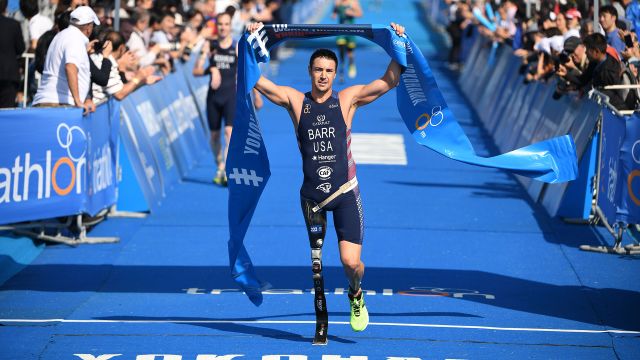Updated on March 25, 2024.
When Mark Barr steps into the water, the world around him washes away. For him, it’s a sanctuary where he is at peace and his body feels whole. After losing his leg to bone cancer 21 years ago, 35-year-old Barr wears a prosthetic limb. But when he swims, it’s a whole different story.
“You just take the leg off,” he says. “When I’m in the water, I’m free and it's amazing.”
Barr began swimming at the age of 4 when his mother, a physical education teacher, begged the local swim coach in Davis, California to let him join the swim team with his two older brothers. A year shy of eligibility, Barr shocked everyone with his natural ability and became a nationally ranked swimmer within six years.
But in 2001, at the age of 14, everything changed. Barr had grown into a multi-sport athlete, also playing soccer and baseball. During practice, he noticed he couldn’t get to first base as quickly as before. His coach assumed it was a lack of effort, but one morning Barr woke up in excruciating pain. He found a golf-ball sized mass on his shinbone.
Initially, Barr’s symptoms were dismissed as Osgood-Schlatter, a common condition that temporarily causes inflammation and knee pain during puberty. But Barr’s symptoms quickly worsened. Being a veterinarian, Barr’s father had some familiarity with reading X-rays. He took another look at his son’s scans and spotted an unusual growth.
Knowing they needed to act quickly, they met with an oncologist who confirmed their suspicions: He had osteosarcoma.
In his young mind, cancer was a death sentence.
Facing the diagnosis and surgery
Osteosarcoma is a rare type of bone cancer. Most osteosarcoma tumors develop in the area around the knee, either in the lower part of the thighbone or the upper part of the shinbone, or the upper arm bone close to the shoulder. They can also metastasize, or spread to other parts of the body, through the bloodstream or lymphatic system.
The five-year survival rate of osteosarcoma cases that haven’t spread is 77 percent, according to the American Cancer Society (ACS). It drops to 65 percent if the cancer has spread to surrounding tissue, organs, or lymph nodes. If the cancer spreads to the lungs or other parts of the body, like in Barr’s case, patients have a five-year survival rate of just 26 percent.
Barr underwent a series of chemotherapy treatments for two months, as well as surgery to remove two masses that had developed in his lungs. But the tumor in his leg was growing—inching dangerously closer to his blood vessels. If they didn’t act quickly, he could not only lose his leg, but also his life. He was left with only one viable option: above-the-knee amputation.
On Sept. 24, 2001, just one month after his 15th birthday, Barr’s parents drove him two hours from their hometown in Davis to a hospital in San Francisco for his surgery. He knew his parents were gripped with uncertainty and concern over how their son’s life would change. Though terrified, Barr admits he also felt relief, knowing his surgery was a necessary step.
In the moments before his surgery, Barr took one final look down at his legs. “It was physically sitting in front of me. When I’m lying in the hospital bed, I could just look down and see this tumor that’s trying to kill me,” he recalls.
Barr knew he wanted the tumor gone—he just didn’t grasp how his life would change. “I didn't know what life as an amputee meant,” Barr says. “What can I do? What can I not do?”
Following surgery, he could have given up his athletic career. But as fate would have it, Barr’s post-surgery recovery nurse was also an amputee who competed in the Paralympics, the Olympics for people with physical disabilities. She told Barr he could do the same.
In that moment, Barr felt a spark reignite within him—one that would light the way through this dark time.
Finding a way forward
Barr was weakened by chemotherapy and had lost muscle mass during his hospitalization. But once he was fitted with a prosthetic leg, he began physical therapy. At first, his prosthetic felt heavy, clunky, and uncomfortable. He began by walking with the parallel bars, hobbling as he fought to take each step with what felt like a 100-pound weight attached to his body. But the repetitive drills provided a welcome sense of familiarity for the young athlete.
On May 5, 2002, Barr was discharged from the hospital. He couldn’t wait to get back into the water with his swim team and to feel like himself again.
“You take the leg off and you're like, ‘Cool, I'm just like another person in the water,’” Barr says. “It was amazing, and I don’t feel any different once I'm in the water.”
Determined to pursue his dreams of becoming an elite athlete, Barr learned to adapt to his disability. He went on to compete as a disabled athlete on the Division 1 swim team at California Polytechnic State University, San Luis Obispo. He made his Paralympic debut at the 2004 Paralympic Games in Athens, where he placed fourth in the 100-meter butterfly and 400-meter freestyle, and returned for the 2008 Paralympic Games in Beijing.
After five years of being cancer-free, Barr was confronted with the future—something he didn’t consider before as the idea of life after cancer never crossed his mind.
“I literally just lived for the moment for the longest time,” he says. “Throughout those five years, I [thought] there was a really good chance I was going to relapse and have to go through all this crap again.”
Paying it forward
Already an elite athlete, Barr decided to give back to the community that helped save his life. He became a nurse in the trauma surgical intensive care unit at a hospital in Houston, Texas. There, he helped patients overcome their physical challenges by sharing his own personal story of perseverance, resilience, and hope.
“Every time you go through stressful things, it builds your character. You come out on the other side stronger,” Barr says, reflecting on his own journey overcoming cancer, chemotherapy, and amputation.
Barr became further involved in the adaptive community over the years. In 2015, he helped found Team Catapult, a local nonprofit organization for adaptive athletes in the Gulf Coast region, just before placing fourth in the triathlon at the Rio de Janeiro 2016 Paralympic Games.
Despite a recent knee injury that required surgery, Barr is tapping into his past to forge ahead. Barr says he meditates over the same advice he offers to other people who find themselves facing a similar obstacle.
“I'm grateful for what I have, and I think that mindset is crucial for people whenever they go through limb loss or any kind of loss—to not focus on the things that you can no longer do, but to focus on things you can do,” Barr says.
Every day, Barr counts his blessings, and each movement is a celebration of what his body can do. When he lost his leg, he never imagined he could eventually gain the life he has now. Today, Barr is surrounded by friends, family, and a thriving community of adaptive athletes and advocates.
“There is life after amputation," he says. "And if I'm not living proof of that, [thousands] of other people are."







